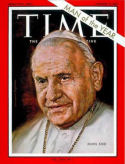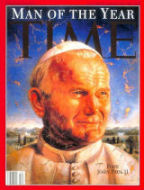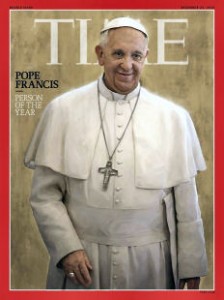Very few popes have ever resigned. Continue reading →
Pope Benedict XVI announced today that he will resign at the end of the month. This is indeed big news because very few of the 263 popes have resigned, and almost every one of those occasions was very controversial.
I have already encountered quite a bit of misleading and outright erroneous information concerning papal resignations. For example, the New York Times website quoted Donald Prudlo, associate professor of history at Jacksonville (AL) State University:
At the end of the 13th century, a very holy hermit named Peter was elected as Pope Celestine V in order to break a deadlock in the conclave that had lasted nearly three years. He was elected because of his personal holiness, sort of a unity candidate. And once he got there, being a hermit, not used to the ways of the Roman Curia, he found himself somewhat unsuited to the task, that it wasn’t just holiness but also some shrewdness and prudence that was also required. So within six months he knew that he was really unequal to the task, and so he gathered the cardinals together in a consistory, just as was recently done, a couple hours ago, and he announced to the cardinals his intention to resign.
Well, he got the time period right. God only knows why the cardinals selected this recluse in the first place. Living alone in a cave in the mountains, the man had eschewed human contact entirely for decades. A letter signed by the hermit had been sent to the conclave. It warned the cardinals that God would wreak vengeance on them and all Christianity if they did not forthwith select a new pope. The cardinals reportedly were so impressed with him that they set aside their previously irreconcilable political differences and endorsed Peter. That is the official account, but anyone who has studied the conclaves of that era would detect the odor of fish. Cardinals are not allowed to disclose the details of conclaves. So, no one can contest the official version.
To me the most annoying aspect of Professor’s Prudlo’s quote is the phrase “once he got there.” “There” must, of course, be Rome, of which the pontiff is by definition the bishop. However, Pope Celestine never once set foot in the Eternal City. Instead, King Charles II of Naples, who may well have been responsible for the letter, convinced His Holiness to take up residence in Castel Nuovo in his capital. Celestine was a total disaster as pope, probably the most incompetent and irresponsible pontiff ever, which is saying something. He kept no records and even bestowed the same benefice (income-generating office) on more than one person. At the instigation of the king, who was French, he appointed a large number of cardinals, most of whom were also French. Celestine never “announced to the cardinals his intention to resign.” Rather, Cardinal Benedict Caetani, drew up a letter of resignation and somehow induced the pontiff to sign it.
That is not the end of the story. Caetani was then swiftly elected as Pope Boniface VIII, and for no specific reason he cast the former pope in prison, which is where he died. I wrote about this episode here.
Very little is known of the popes of the first few centuries. The story has come down that Pope Pontian, who was exiled to the salt mines of Sardinia, might have resigned so that someone else could serve as the Bishop of Rome (whom no one thought of as the pope at the time). He might have done so, but then again some of his predecessors might also have hung up their miters. In fact, Clement I, the fourth pope, wrote in some of his letters that St. Peter himself had consecrated him (Clement) as Bishop of Rome. If so, then the first pope to resign must have been the very first pope, St. Peter!
The last pope to resign was Pope Gregory XII in 1415. What a story that was! At the time there were three claimants to the papal throne, and all three arguably had legitimate cases. One of them, John XXIII (no, not that John XXIII) called a council in Constance, a city next to a very deep lake in southern Germany, in order to resolve the situation. He badly misjudged the politics, however, and the council put him on trial for five felonies, deposed him, and threw him in prison. A second claimant, Benedict XIII, had been holed up in a corner of Spain for some time. He refused to come to the council and was also eventually deposed.
Pope Gregory also rejected the council’s summons. However, after the other two claimants had been deposed, he sent a letter through an emissary in which he expressed his willingness to resign. It is worth noting that he died before the council could agree on his successor, Pope Martin V. So, assuming that Pope Benedict lives to see his successor chosen, it will be the first time since the thirteenth century that the Church will have both a pope and a living ex-pope.
Did you notice anything strange in the above paragraph? Martin V was chosen, not by the college of cardinals but by the council, which included many clergy of much lower rank and was heavily influenced by Emperor Sigismund. The problem was that during the Western Schism, which had gone on for decades, there had been multiple papal claimants each supported by influential spiritual and civil leaders. Each pontiff had appointed cardinals loyal to him and had excommunicated those appointed by rivals. So, it was easier for everyone at Constance just to ignore canon law for a while. Hundreds of those who refused to go along found their way to the bottom of the lake. The surviving cardinals were reinstated, regardless of who had appointed them. What else could they do? Pope Martin himself had been appointed by the deposed and disgraced John XXIII.
I wrote about the Council of Constance here.
I cannot leave this subject without bringing up the one pope who certainly resigned of his own accord. Here is what Professor Prudlo had to say about Pope Benedict IX:
And then, at a rather low point in the Church’s history, Pope Benedict IX, in the 1040s, resigned and attempted to re-acquire the papacy several times. But according to good reports, he too died in penance at the monastery of Grottaferrata outside of Rome.
In point of fact, no one disputes the fact that Pope Benedict IX sold the papacy to his godfather, John Gratian, who became Pope Gregory VI. At the time Benedict had been pontiff for more than a decade, but he was still a young man, and he wanted to get married. However, his prospective father-in-law would only approve if Benedict abdicated. Yes, some popes have been married, but no pope that we know of ever got married while he was pontiff.
After Gregory had been deposed by the emperor, a jilted Benedict managed to acquire the papacy again for a short while. The “good reports” that he retired to Grottaferrata really amount to the word of one monk. Via e-mail I personally asked Santo Lucà, a professor at La Sapienza who is probably the world’s expert on the history of Grottaferrata, whether he thought that the pope had retired there. His answer: “Assolutamente no!”
* * *So why have so few popes resigned? The primary answer is that from 800 until 1870 the pope was the monarch of central Italy. Most of the popes of that period amassed great amounts of wealth and spread it among family members. They did not resign for the same reason that very few kings and queens have abdicated — they knew that they had the best gig in town. Furthermore, unlike kings and queens, the popes had very limited control over their successors. In many cases the successor had little respect for the work of the predecessor, and the popes knew that. The best way for a pope to protect his historical legacy was to stretch it out as long as possible. When the duties became too much for an aging pontiff, he customarily assigned the most important tasks to a relative, usually a nephew.
Since 1870 the popes have been too busy to resign. Pius IX devoted himself to overthrowing the Italian (and to an extent American) government in order to reclaim his territory. Leo XIII was busy with his poetry, his snuff, his movies, and his cocaine-laced wine. Pius X fought against modernism. Benedict XV fought for peace. Pius XI and Pius XII had to confront the Nazis, the fascists, and the communists. John XXIII (yes, that John XXIII) tried to drag the Church into the twentieth century. Paul VI tried to smooth the feathers that had been ruffled by his predecessor. John Paul I only lasted a month. John Paul II worked to destroy communism and to restore conservative traditions.
Only Benedict XVI had no clear mission. It is a little-known fact that he had asked to resign when John Paul II was still alive. Why are people surprised that an 86-year-old man would want some rest?
 Two popes had previously been named Time magazine’s Man of the Year. John XXIII was chosen for 1962, the year that he opened the Second Vatican Council and charged it with bringing the Church into the twentieth century, or at least the Age of Enlightenment. It was a dramatic decision. The Church had not convened an ecumenical council in a century, and that last one was called to rubber stamp decisions made by Pope Pius IX. In contrast, John XXIII had set in place a mechanism for listening to new ideas and implementing the best of them.
Two popes had previously been named Time magazine’s Man of the Year. John XXIII was chosen for 1962, the year that he opened the Second Vatican Council and charged it with bringing the Church into the twentieth century, or at least the Age of Enlightenment. It was a dramatic decision. The Church had not convened an ecumenical council in a century, and that last one was called to rubber stamp decisions made by Pope Pius IX. In contrast, John XXIII had set in place a mechanism for listening to new ideas and implementing the best of them. John Paul II was chosen for 1994. By that time the pontiff’s role in undermining the Communist governments in eastern Europe was becoming clear. He provided spiritual support for all of those movements, and he did much more than that for Poland. Many people still do not realize that the Vatican bank underwrote the political campaigns of the Solidarity Trade Union that eventually brought independence and democracy, not to mention the resurgence of Catholicism, to the Polish people.
John Paul II was chosen for 1994. By that time the pontiff’s role in undermining the Communist governments in eastern Europe was becoming clear. He provided spiritual support for all of those movements, and he did much more than that for Poland. Many people still do not realize that the Vatican bank underwrote the political campaigns of the Solidarity Trade Union that eventually brought independence and democracy, not to mention the resurgence of Catholicism, to the Polish people. Pope Francis has certainly made a number of startling statements and gestures. It is difficult to imagine any of his 263* predecessors uttering the words, “Who am I to judge?” His washing of the feet of others and, indeed, his choice of the name “Francis” were no doubt acts of symbolic importance.
Pope Francis has certainly made a number of startling statements and gestures. It is difficult to imagine any of his 263* predecessors uttering the words, “Who am I to judge?” His washing of the feet of others and, indeed, his choice of the name “Francis” were no doubt acts of symbolic importance.
